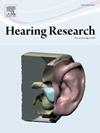Intracochlear electric potential measurements for estimating electrode array position in cochlear implantation: The in vivo utility of an ex vivo model
IF 2.5
2区 医学
Q1 AUDIOLOGY & SPEECH-LANGUAGE PATHOLOGY
引用次数: 0
Abstract
Introduction
Stimulation of cochlear implant electrodes generates intracochlear electric potentials. The local electric potentials can be assessed using e.g. transimpedance matrix (TIM) and four-point impedance (Zfp). Both of these measurements are dependent on the cochlear dimensions and the distance between the electrode and the medial wall of the scala tympani (dEM). In a recent temporal bone study, a model based on electric potential measurements gave good predictions of scalar cross-sectional area (Ascala) and dEM. The purpose of this study was to further improve this model and evaluate its clinical usefulness. To this end, the intraoperative TIM and Zfp measurements from cochlear implant patients were used as independent variables in the model to predict their Ascala and dEM at each electrode contact, which were then compared to those measured from postoperative cone-beam computed tomography (CBCT) images.
Methods
In an earlier study, six cadaveric temporal bones were sequentially implanted with three different electrode arrays: a lateral-wall electrode array, Slim Straight, and two precurved perimodiolar electrode arrays, Contour Advance and Slim Modiolar (Cochlear Ltd, Sydney, Australia). The TIM and Zfp measurements were performed alongside CBCT imaging, from which the Ascala and dEM at each electrode contact were measured. From the TIM measurements, the peak amplitudes and decay rate of the electric potentials (EPslope) were computed. In this follow-up study, the statistical modeling of the ex vivo measurements was refined to better account for individual characteristics by employing mixed-effect models to predict the Ascalas and dEMs. Then, in vivo recordings from thirteen patients, of which six were implanted with the Slim Straight and seven with the Contour Advance electrode arrays, were retrospectively analyzed. The Ascalas and dEMs were measured from their postoperative CBCT images in a similar manner to the temporal bones. To validate the mixed-effects models developed with the temporal bone data, the patients’ intraoperative TIM and Zfp measurements were used as independent parameters in the models to predict their Ascalas and dEMs. Finally, the TIM and Zfp parameters measured in vivo and ex vivo and the measured and predicted Ascalas and dEMs were compared using t-tests. Also, Pearson’s correlation coefficients were computed between the measured and predicted in vivo Ascalas and dEMs.
Results
Both the amplitudes, indicating electric potential peaks, and Zfps, reflecting local potential differences, were lower in vivo than ex vivo (790 vs. 1090 Ω and 253 vs. 270 Ω, respectively, p < 0.001 for both), but no differences were detected in the decay of the electric potentials. In addition, the in vivo Zfps were lower, and the electric potential decay was slower with the lateral wall (Slim Straight) compared to perimodiolar (Contour Advance) array (234 vs. 284 Ω and −94 vs. −160 Ω/mm, p < 0.001 for both). The mixed effects models with and without random effects explained 73 % and 51 % of the variance, respectively, for Ascala. The mean absolute error between measured and predicted Ascalas was 12 %. For dEMs, the corresponding percentages were 65 %, 50 %, and 51 %. The correlations between the patients’ measured and predicted Ascalas and dEMs were r = 0.60 and r = 0.48 (p < 0.001, for both). When compared in the basal, middle, and apical sections, the predicted Ascalas differed significantly from the measured values only in the middle section of the array (4.0 ± 0.48 mm vs 3.50 ± 0.36 mm, p < 0.001). For dEMs, the model gave too large estimates in the apical section of the array (1.04 ± 0.49 mm vs. 1.52 ± 0.48, p < 0.001).
Conclusion
The Ascala at each electrode contact can be estimated using the TIM and Zfp measurements, which may help verify the correct alignment of the electrode array during the surgery. While the measured and predicted dEMs correlated with each other, there were significant differences between their absolute values. Given the large variation in dEMs for different array types, electrode-specific dEMs models could improve the accuracy of the predictions.
耳蜗植入中估计电极阵列位置的耳蜗内电位测量:离体模型的体内效用
人工耳蜗电极刺激可产生耳蜗内电位。局部电位可以用透阻抗矩阵(TIM)和四点阻抗(Zfp)来评估。这两种测量都取决于耳蜗的尺寸和电极与鼓室内壁(dEM)之间的距离。在最近的颞骨研究中,基于电势测量的模型可以很好地预测标量横截面积(Ascala)和dEM。本研究的目的是进一步完善该模型并评价其临床应用价值。为此,将人工耳蜗患者术中TIM和Zfp测量值作为模型中的独立变量,预测其每次电极接触时的Ascala和dEM,然后将其与术后锥束计算机断层扫描(CBCT)图像测量值进行比较。方法在早期研究中,将6具颞骨依次植入3种不同的电极阵列:侧壁电极阵列Slim Straight和两种预弯曲的磨牙周围电极阵列Contour Advance和Slim Modiolar (Cochlear Ltd, Sydney, Australia)。TIM和Zfp测量与CBCT成像一起进行,通过CBCT成像测量每个电极接触处的Ascala和dEM。根据TIM的测量结果,计算了电位的峰值幅度和衰减率(EPslope)。在这项后续研究中,通过使用混合效应模型来预测Ascalas和dem,对离体测量的统计模型进行了改进,以更好地考虑个体特征。然后,对13例患者的体内记录进行回顾性分析,其中6例植入Slim Straight, 7例植入Contour Advance电极阵列。Ascalas和dem从其术后CBCT图像中以类似于颞骨的方式测量。为了验证利用颞骨数据建立的混合效应模型,将患者术中TIM和Zfp测量作为模型中的独立参数来预测患者的Ascalas和dem。最后,采用t检验比较在体内和离体测量的TIM和Zfp参数以及测量和预测的Ascalas和dem。同时,计算体内Ascalas和dem测量值与预测值之间的Pearson相关系数。结果表明电位峰值的振幅和反映局部电位差的Zfps在体内均低于离体(分别为790 vs 1090 Ω和253 vs 270 Ω);两者均为0.001),但在电位衰减方面没有发现差异。此外,与磨牙周(轮廓推进)阵列相比,体内Zfps更低,与侧壁(Slim Straight)相比电位衰减更慢(234 vs. 284 Ω和- 94 vs. - 160 Ω/mm, p <;两者均为0.001)。对于Ascala,有和没有随机效应的混合效应模型分别解释了73%和51%的方差。测量值和预测值之间的平均绝对误差为12%。对于民主党,相应的百分比分别为65%、50%和51%。患者Ascalas测量值和预测值与dem的相关性分别为r = 0.60和r = 0.48 (p <;两者都是0.001)。在基底、中部和根尖切片中,预测的Ascalas与阵列中部的实测值存在显著差异(4.0±0.48 mm vs 3.50±0.36 mm, p <;0.001)。对于dem,该模型在阵列的顶端部分给出了过大的估计(1.04±0.49 mm vs. 1.52±0.48,p <;0.001)。结论利用TIM和Zfp测量可以估计每个电极接触处的Ascala,这有助于在手术过程中验证电极阵列的正确对准。虽然测量和预测的dem相互相关,但它们的绝对值之间存在显著差异。考虑到不同阵列类型的dem差异很大,电极特定的dem模型可以提高预测的准确性。
本文章由计算机程序翻译,如有差异,请以英文原文为准。
求助全文
约1分钟内获得全文
求助全文
来源期刊

Hearing Research
医学-耳鼻喉科学
CiteScore
5.30
自引率
14.30%
发文量
163
审稿时长
75 days
期刊介绍:
The aim of the journal is to provide a forum for papers concerned with basic peripheral and central auditory mechanisms. Emphasis is on experimental and clinical studies, but theoretical and methodological papers will also be considered. The journal publishes original research papers, review and mini- review articles, rapid communications, method/protocol and perspective articles.
Papers submitted should deal with auditory anatomy, physiology, psychophysics, imaging, modeling and behavioural studies in animals and humans, as well as hearing aids and cochlear implants. Papers dealing with the vestibular system are also considered for publication. Papers on comparative aspects of hearing and on effects of drugs and environmental contaminants on hearing function will also be considered. Clinical papers will be accepted when they contribute to the understanding of normal and pathological hearing functions.
 求助内容:
求助内容: 应助结果提醒方式:
应助结果提醒方式:


